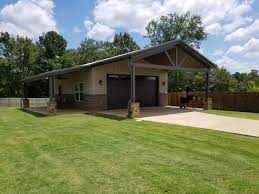Introduction:
In the ever-evolving world of construction, metal buildings have emerged as a revolutionary and versatile solution that has transformed the landscape of architecture. Gone are the days when metal structures were associated solely with warehouses and industrial facilities. Today, metal buildings have become a symbol of innovation, sustainability, and efficiency. In this blog post, we will explore the evolution of metal buildings, their diverse applications, and the numerous benefits that make them a preferred choice in contemporary construction.

The Origins of Metal Buildings:
The history of metal buildings can be traced back to the 20th century when advancements in metallurgy and engineering paved the way for new construction techniques. The initial use of metal structures was primarily in the industrial sector, where the need for large, cost-effective, and durable buildings was paramount. As technology progressed, architects and builders began to recognize the potential of metal in creating structures that went beyond mere functionality.
Versatility in Design:
One of the key reasons behind the popularity of metal buildings is their versatility in design. Modern architects now use metal as a primary building material, allowing for a wide range of aesthetic possibilities. From sleek and contemporary designs to more traditional and rustic appearances, metal buildings have broken free from the rigid stereotypes of the past. This adaptability has made them a favorite choice for various applications, including commercial, residential, and institutional projects.
Structural Advancements:
Technological advancements have played a crucial role in enhancing the structural integrity of metal buildings. The use of high-strength steel and advanced engineering techniques has resulted in structures that can withstand extreme weather conditions, seismic activities, and other environmental challenges. The lightweight nature of metal also contributes to faster construction times and reduces the overall load on the foundation, making these buildings a cost-effective and sustainable choice.
Energy Efficiency and Sustainability:
In an era where sustainability is at the forefront of construction practices, metal buildings shine as eco-friendly options. Many metal buildings are constructed using recycled materials, and the recyclability of steel makes them a sustainable choice. Additionally, metal roofs can be designed to reflect sunlight, reducing the heat absorbed by the building and contributing to energy efficiency. As more industries prioritize environmentally conscious practices, the demand for sustainable construction materials, like metal, continues to grow.
Cost-Effective Construction:
Metal buildings are renowned for their cost-effectiveness in both construction and maintenance. The prefabrication of metal components in factories significantly reduces on-site construction time and labor costs. The durability of metal also translates to lower maintenance expenses over the lifespan of the building. These cost advantages make metal buildings an attractive option for developers, businesses, and individuals looking to optimize their budgets without compromising on quality.
Applications Across Industries:
While metal buildings initially gained popularity in the industrial sector, their applications have expanded across various industries. Commercial spaces, educational institutions, agricultural facilities, and even residential homes now feature metal components in their construction. The versatility, durability, and cost-effectiveness of metal make it an ideal choice for a wide array of projects, regardless of scale or purpose.
Innovations in Design and Technology:
The integration of technology in the design and construction of metal buildings has brought about innovative solutions. Building Information Modeling (BIM) allows architects and engineers to create detailed 3D models, optimizing the design process and ensuring precision in construction. Additionally, advancements in insulation materials and coatings contribute to enhanced energy efficiency, addressing previous concerns about the thermal conductivity of metal.
Challenges and Solutions:
Despite the numerous benefits of metal buildings, challenges such as corrosion and aesthetic concerns have been raised. However, ongoing research and development efforts have led to the introduction of corrosion-resistant coatings and finishes that address these issues. Additionally, the aesthetic appeal of metal buildings continues to improve with creative architectural designs and the use of various cladding materials.
Conclusion:
The evolution of metal buildings from simple industrial structures to architectural marvels is a testament to the adaptability and innovation within the construction industry. Today, metal buildings stand as symbols of sustainability, efficiency, and versatility, challenging preconceived notions about their limitations. As technology continues to advance and the demand for sustainable construction practices rises, the future of metal buildings appears promising, offering solutions to the ever-changing needs of the built environment. Whether in urban landscapes or rural settings, the impact of metal buildings is undeniable, shaping the way we envision and construct the world around us.

No comments yet